The Age Related Vision Dysfunction Market is estimated to be valued at USD 96.8 billion in 2025 and is projected to reach USD 139.2 billion by 2035, registering a compound annual growth rate (CAGR) of 3.7% over the forecast period.
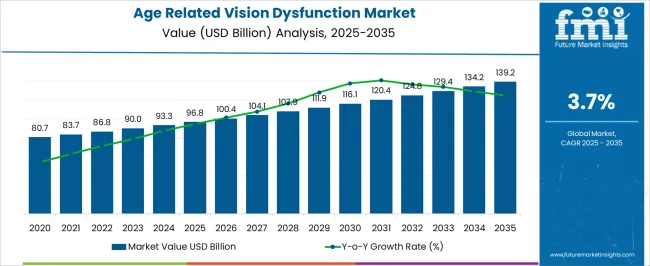
| Metric | Value |
|---|---|
| Age Related Vision Dysfunction Market Estimated Value in (2025 E) | USD 96.8 billion |
| Age Related Vision Dysfunction Market Forecast Value in (2035 F) | USD 139.2 billion |
| Forecast CAGR (2025 to 2035) | 3.7% |
The age related vision dysfunction market is undergoing steady expansion as demographic shifts, technological progress, and improved access to care converge to drive demand for effective interventions. Increasing life expectancy and rising prevalence of age related eye disorders have intensified focus on early detection and targeted treatment approaches.
The market is being shaped by advancements in diagnostic tools, growing awareness of vision health, and wider availability of innovative therapies. Future growth is expected to be fueled by ongoing research into disease-modifying treatments, patient-centric care models, and supportive healthcare policies.
Clinical innovation, coupled with proactive screening initiatives, is paving the way for broader adoption of both surgical and pharmacological solutions while addressing unmet needs in aging populations.
The market is segmented by Dysfunction Type and Drug and region. By Dysfunction Type, the market is divided into Cataract, AMD, Glaucoma, and Presbyopia. In terms of Drug, the market is classified into Eylea, Rocklatan, Eybelis Ophthalmic Solution, Xelpros, Rhopressa, Vyzulta, Glanatec, Simbrinza, Tapcom/DE-111, Azarga/Azorga, Combigan, Lucentis, and Beovu. Regionally, the market is classified into North America, Latin America, Western Europe, Eastern Europe, Balkan & Baltic Countries, Russia & Belarus, Central Asia, East Asia, South Asia & Pacific, and the Middle East & Africa.
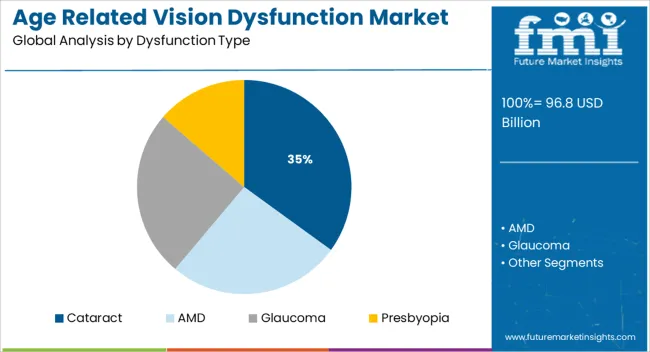
When segmented by dysfunction type, cataract is projected to hold 35.0% of the total market revenue in 2025, establishing itself as the leading dysfunction segment. This leadership is supported by its high global prevalence among older adults and the availability of effective surgical and therapeutic interventions.
Widespread adoption of advanced surgical techniques and intraocular lenses has made treatment outcomes more predictable and accessible. Increasing patient awareness and reduced procedural risks have encouraged earlier intervention, sustaining the segment’s growth.
The ability to restore functional vision and improve quality of life at scale has positioned cataract as the most significant contributor to market revenue, with ongoing innovations continuing to reinforce its dominance.
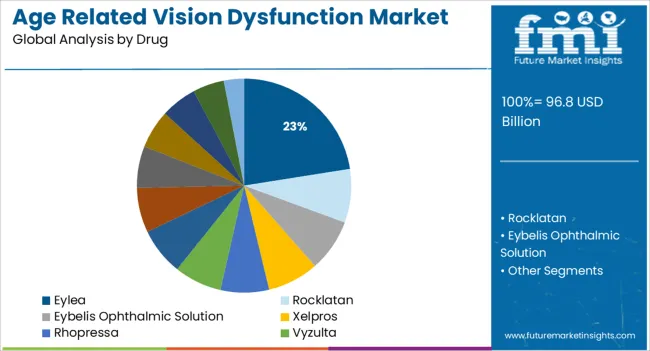
In terms of drug, Eylea is expected to capture 22.5% of the total market revenue in 2025, making it the leading drug segment. This prominence has been driven by its proven efficacy in treating a range of retinal disorders associated with age related vision loss, including wet age related macular degeneration and diabetic macular edema.
Its sustained clinical performance and favorable safety profile have strengthened physician confidence and patient adherence. Expanded indications and increased accessibility through healthcare programs have further accelerated its adoption.
The ability to deliver meaningful visual improvements with manageable treatment regimens has solidified Eylea’s position as a cornerstone therapy in the pharmacologic management of vision dysfunction, ensuring its continued leadership in the market.
The global demand for age-related vision dysfunction is projected to increase at a CAGR of 3.7% during the forecast period between 2025 and 2035, reaching a total of USD 139.2 Billion in 2035, according to a report from Future Market Insights (FMI). From 2020 to 2025, sales witnessed significant growth, registering a CAGR of 2%.
The prevalence of rising eye disorders among individuals from all walks of life is predicted to fuel demand for age-related vision dysfunction, notwithstanding a major increase. The number of patients attending eye care hospitals has increased due to a rise in incidences of cataracts and glaucoma. According to WHO figures, more than 4.5 million individuals are blind as a result of glaucoma. This is concerning, and it has pushed glaucoma patients to adopt preventive measures.
An Increase in the Proportion of Geriatrics to Encourage Market Expansion
As people age, their eye lenses get stiffer, making it difficult to focus on objects in close proximity. This disorder is known as presbyopia, and it is frequent in persons over the age of 70.
This is usually corrected by using bifocal or progressive lenses. During the projection period, this is likely to improve growth prospects of age-related vision dysfunction.
Advancements in Ophthalmic Diagnostic and Treatment Technologies to boost Adoption
The technical developments that are occurring in this sector are the primary drivers of the age-related vision dysfunction industry. The use of nanotechnology in vision care is predicted to revolutionize the market.
Nanotechnology is now being used to detect eye pressure, cure retinal disorders, and help patients recover from glaucoma faster. Furthermore, robots are used in conjunction with human intelligence to precisely place surgical equipment during eye surgery. Artificial retinas with electrodes are used to replace injured retinas. This might increase future demand for age-related vision dysfunction treatment.
Increasing Awareness-raising Campaigns concerned with Eye Dysfunction
Whether it is the government or large corporations, they are all taking measures to raise awareness about age-related vision dysfunction and its treatment. The World Health Organization (WHO) and the International Agency for the Prevention of Blindness (IAPB) partnered with the Indian government to create VISION 2024. They also put on World Sight Day and other activities.
The goal was to raise awareness about various eye disorders and the procedures to take to keep healthy eyes. This might boost the age-related vision dysfunction market throughout the predicted period. Artificial retinas with electrodes are used to replace injured retinas. This might increase future demand for age-related vision dysfunction treatments.
High Price of Medication to Hamper Market Growth
The high pricing of medications is going to put pressure on corporations and drug makers, particularly on therapies with a high price (i.e. gene therapies) that provide no additional major advantages.
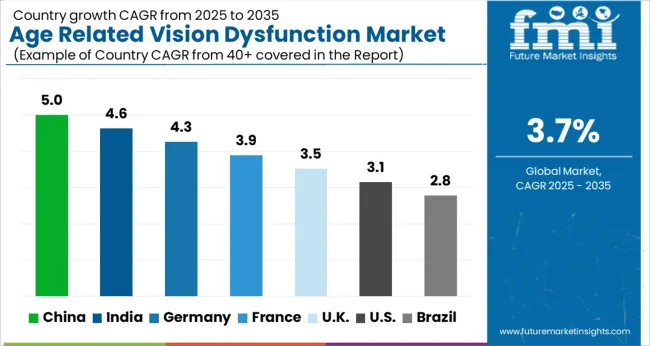
Rapid Technological Development for Widening Profit Margins
During the projected period, the Chinese age-related vision dysfunction market is predicted to develop at a healthy CAGR of 3.6%. Some of the reasons driving the Chinese age-related vision dysfunction market are the raising geriatric population, rapid technological development, and a growing inclination for superior eye care goods.
According to a Lancet investigation, there were more than 45 million individuals in China with moderate visual impairment, 4.6 million with severe vision impairment, and about 8.7 million with blindness. Furthermore, according to studies, China is one of the world's largest markets for age-related vision dysfunction treatments. Because of technical improvements, China's top businesses are offering novel vision care goods at cheap prices.
On the other hand, according to FMI research, the India age-related vision dysfunction market is estimated to develop at a CAGR of 3% over the forecast period. People have begun to adopt sedentary lifestyles as cities have grown in size. As a result, individuals begin to acquire numerous health concerns, the most evident of which is eye damage in many cases.
Furthermore, the use of technological gadgets is increasing. This opens up a big possibility for the vision care sector in the future. As per Future Market Insights, the Asia Pacific is expected to grow at a CAGR of 3.5% in the assessment period 2025-2035.
Growing Senior Population to Accelerate Market Growth
According to FMI research, the North American age-related vision dysfunction market is predicted to develop at a CAGR of 3.6% during the forecast period. The market is likely to be driven by a growing senior population, favorable government policies, and an increase in the incidence of eye illnesses among individuals of all ages.
According to the Centers for Disease Control and Prevention, almost 12 million Americans over the age of 40 have vision impairment. This has been connected to an increase in diabetes incidence in the region. The government and several corporate entities are launching awareness campaigns to keep the issue under control.
Furthermore, the leading businesses are utilizing cutting-edge technology to provide the greatest products possible. Aside from that, the rapid expansion of the E-Commerce industry is predicted to fuel the market in the United States. The United States is predicted to be the top country in North America, with a market share of 33.8% in the area.
Key start-up players in the age-related vision dysfunction are offering new and innovative product lines to consolidate their market presence, these aforementioned start-ups have left no stone unturned. Some specific instances of key age-related vision dysfunction start-ups are as follows:
Nanodropper, Inc. was established in 2020. It has created an eye drop bottle converter that reduces the capacity of large eyedrops by more than 60%. This is done with the goal of reducing waste and costs.
Visus Therapeutics is a company that was created in 2020. Their primary goal has always been to provide fixed formulation eye drops for presbyopia sufferers.
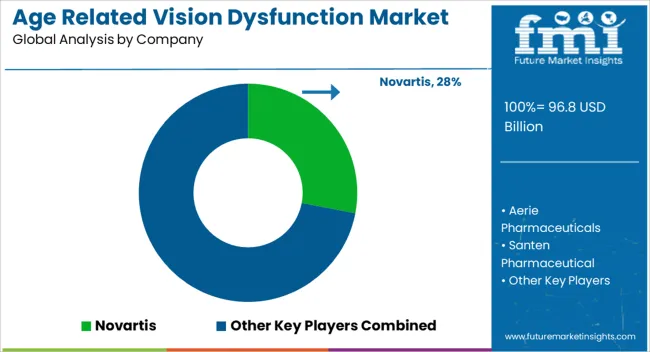
The main market participants are taking all feasible measures to execute the proper activities in order to lessen the rising number of age-related vision dysfunction sufferers globally. They are getting into strategic relationships with start-ups to solve some of the issues that patients confront when undergoing treatment for this purpose. The leading stakeholders are on a quest to create minimally invasive surgical treatments for this purpose. Key players in the age-related vision dysfunction market are:
Recent Developments:
| Report Attribute | Details |
|---|---|
| Market Value in 2025 | USD 96.8 billion |
| Market Value in 2035 | USD 139.2 billion |
| Growth Rate | CAGR of 3.7% from 2025 to 2035 |
| Base Year for Estimation | 2025 |
| Historical Data | 2020 to 2025 |
| Forecast Period | 2025 to 2035 |
| Quantitative Units | Revenue in US Billion and CAGR from 2025 to 2035 |
| Report Coverage | Revenue Forecast, Company Ranking, Competitive Landscape, Growth Factors, Trends, and Pricing Analysis |
| Segments Covered | Dysfunction Type, Drug, Region |
| Regions Covered | North America; Latin America; Europe; Asia Pacific; Middle East and Africa (MEA) |
| Key Countries Profiled |
The USA, Canada, Brazil, Mexico, Germany, The UK, France, Spain, Italy, China, Japan, South Korea, India, Malaysia, Singapore, Thailand, Indonesia, Australia, New Zealand, GCC, South Africa, Israel |
| Key Companies Profiled | Aerie Pharmaceuticals; Santen Pharmaceutical; Sun Pharma Advanced Research Company Limited; Bausch + Lomb; D Western Therapeutics Institute; Novartis; AbbVie; Eyenovia; Orasis Pharmaceuticals; IVERIC Bio |
| Customization | Available Upon Request |
The global age related vision dysfunction market is estimated to be valued at USD 96.8 billion in 2025.
The market size for the age related vision dysfunction market is projected to reach USD 139.2 billion by 2035.
The age related vision dysfunction market is expected to grow at a 3.7% CAGR between 2025 and 2035.
The key product types in age related vision dysfunction market are cataract, amd, glaucoma and presbyopia.
In terms of drug, eylea segment to command 22.5% share in the age related vision dysfunction market in 2025.






Our Research Products

The "Full Research Suite" delivers actionable market intel, deep dives on markets or technologies, so clients act faster, cut risk, and unlock growth.

The Leaderboard benchmarks and ranks top vendors, classifying them as Established Leaders, Leading Challengers, or Disruptors & Challengers.

Locates where complements amplify value and substitutes erode it, forecasting net impact by horizon

We deliver granular, decision-grade intel: market sizing, 5-year forecasts, pricing, adoption, usage, revenue, and operational KPIs—plus competitor tracking, regulation, and value chains—across 60 countries broadly.

Spot the shifts before they hit your P&L. We track inflection points, adoption curves, pricing moves, and ecosystem plays to show where demand is heading, why it is changing, and what to do next across high-growth markets and disruptive tech

Real-time reads of user behavior. We track shifting priorities, perceptions of today’s and next-gen services, and provider experience, then pace how fast tech moves from trial to adoption, blending buyer, consumer, and channel inputs with social signals (#WhySwitch, #UX).

Partner with our analyst team to build a custom report designed around your business priorities. From analysing market trends to assessing competitors or crafting bespoke datasets, we tailor insights to your needs.
Supplier Intelligence
Discovery & Profiling
Capacity & Footprint
Performance & Risk
Compliance & Governance
Commercial Readiness
Who Supplies Whom
Scorecards & Shortlists
Playbooks & Docs
Category Intelligence
Definition & Scope
Demand & Use Cases
Cost Drivers
Market Structure
Supply Chain Map
Trade & Policy
Operating Norms
Deliverables
Buyer Intelligence
Account Basics
Spend & Scope
Procurement Model
Vendor Requirements
Terms & Policies
Entry Strategy
Pain Points & Triggers
Outputs
Pricing Analysis
Benchmarks
Trends
Should-Cost
Indexation
Landed Cost
Commercial Terms
Deliverables
Brand Analysis
Positioning & Value Prop
Share & Presence
Customer Evidence
Go-to-Market
Digital & Reputation
Compliance & Trust
KPIs & Gaps
Outputs
Full Research Suite comprises of:
Market outlook & trends analysis
Interviews & case studies
Strategic recommendations
Vendor profiles & capabilities analysis
5-year forecasts
8 regions and 60+ country-level data splits
Market segment data splits
12 months of continuous data updates
DELIVERED AS:
PDF EXCEL ONLINE
Age-Defying Night Creams Market Analysis - Size and Share Forecast Outlook 2025 to 2035
AI-Driven Agent-Based Modeling – Predictive Insights & Analysis
Age Related Molecular Degeneration Market Size and Share Forecast Outlook 2025 to 2035
Sage Extract Market Size and Share Forecast Outlook 2025 to 2035
Sage Essential Oil Market Analysis by Source, Application, Distribution Channel, and Region Through 2035
Lager Market Trends - Brewing Innovations & Consumer Demand 2025 to 2035
Image-Guided Injectables Market Forecast and Outlook 2025 to 2035
Image Guided Radiotherapy Market Size and Share Forecast Outlook 2025 to 2035
Phage MuA Transposase Market Size and Share Forecast Outlook 2025 to 2035
Image Recognition in Retail Market Size and Share Forecast Outlook 2025 to 2035
Image Intensifier Market Analysis - Size, Share & Forecast Outlook 2025 to 2035
Reagent Bottle Market Growth & Industry Forecast 2025 to 2035
Image Guided Systems Market is segmented by product type, application and end user from 2025 to 2035
Reagent Filling Systems Market Analysis – Growth & Forecast 2024-2034
Imagery Analytics Market Analysis – Growth & Forecast through 2034
Image Sensors Market Growth – Trends & Forecast through 2034
Image Based Barcode Reader Market Growth – Trends & Forecast 2020-2030
Image-Based Cytometer Market
Damaged Starch Analyzer Market Size and Share Forecast Outlook 2025 to 2035
Garage Equipment Market Forecast and Outlook 2025 to 2035

Thank you!
You will receive an email from our Business Development Manager. Please be sure to check your SPAM/JUNK folder too.
Chat With
MaRIA